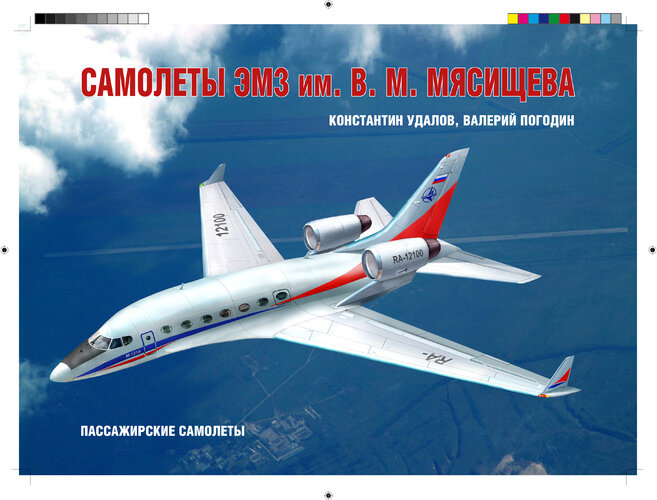gabrielorosco
I really should change my personal text
- Joined
- 10 December 2016
- Messages
- 177
- Reaction score
- 203
Hello to all!
Today I had the chance to take a look at the new book wrote by our friend Konstantin Udalov (Ucon). It is another volume devoted to the projects of the Myasischev Design Bureau, specifically passenger aircraft designs.
During the years between 1980 and early 90’s, the political situation in the Soviet Union allowed the aircraft design bureaus once focused in military projects, to develop new civilian aircraft, as the need for such kind of transport increased following the implementation of the perestroika political plan. The MDB, as one of the most important aircraft developers in the USSR, proposed a series of small, intermediate range passenger aircraft, to fill the existing gap of the business aircraft subject.
The first part book introduces the aircraft nicknamed “dolphin”, along with all of its developed variants (M-101 and M-102) and the M-202. These small passenger aircraft had some advanced features in its configurations, most notably, the pusher installation of its turboprop engines, a concept not so common at the time. The different variants had improvements over the previous ones, regarding the modular interior, ability to transport passengers and cargo, different engine positions and numbers and even the radical forward swept wings (like those adopted in the later Sukhoi 47).
The M-202 model was also developed for military use, such as strategic reconnaissance and maritime patrol. This last one was meant to be very advanced, featuring almost all kinds of equipment present in larger maritime patrol designs, specially long range radars and the MAD (Magnetic Anomaly Detector), designed for the Anti-Submarine Warfare (ASW).
In the second part of the book, attention is paid for the jet engines design. This series of aircraft were comprised of the models M-302 and M-121, again with a large list of variants. The M-302 is described as not being much different of its predecessors, apart from the adoption of jet engines, configured with a VIP cabin for regional routes.
The big surprise comes with the M-121 designs. While the first members of these series were larger, conventional and regional jets, Myasischev evolved the design with some features not present even today in the business aviation. Radical changes were used to increase the aircraft efficiency, most notably the adoption of the BWB structure (Blended Wing Body), resulting in larger, slender aircraft with a huge internal space, a concept that could perfectly fill the gap in the present aviation of this type.
It is important to say that this book is one of the most illustrated I’ve ever seen, with detailed drawings of each aircraft variant. The presence of original documents is also big, creating a parallel between originality and 3D reconstructions. I really recommend such a book for specialists and aviation enthusiasts, as it not only tell stories of the past, but connect it with the present and pave the way for a near future in world’s aviation. Wish everyone a very nice reading!
Today I had the chance to take a look at the new book wrote by our friend Konstantin Udalov (Ucon). It is another volume devoted to the projects of the Myasischev Design Bureau, specifically passenger aircraft designs.
During the years between 1980 and early 90’s, the political situation in the Soviet Union allowed the aircraft design bureaus once focused in military projects, to develop new civilian aircraft, as the need for such kind of transport increased following the implementation of the perestroika political plan. The MDB, as one of the most important aircraft developers in the USSR, proposed a series of small, intermediate range passenger aircraft, to fill the existing gap of the business aircraft subject.
The first part book introduces the aircraft nicknamed “dolphin”, along with all of its developed variants (M-101 and M-102) and the M-202. These small passenger aircraft had some advanced features in its configurations, most notably, the pusher installation of its turboprop engines, a concept not so common at the time. The different variants had improvements over the previous ones, regarding the modular interior, ability to transport passengers and cargo, different engine positions and numbers and even the radical forward swept wings (like those adopted in the later Sukhoi 47).
The M-202 model was also developed for military use, such as strategic reconnaissance and maritime patrol. This last one was meant to be very advanced, featuring almost all kinds of equipment present in larger maritime patrol designs, specially long range radars and the MAD (Magnetic Anomaly Detector), designed for the Anti-Submarine Warfare (ASW).
In the second part of the book, attention is paid for the jet engines design. This series of aircraft were comprised of the models M-302 and M-121, again with a large list of variants. The M-302 is described as not being much different of its predecessors, apart from the adoption of jet engines, configured with a VIP cabin for regional routes.
The big surprise comes with the M-121 designs. While the first members of these series were larger, conventional and regional jets, Myasischev evolved the design with some features not present even today in the business aviation. Radical changes were used to increase the aircraft efficiency, most notably the adoption of the BWB structure (Blended Wing Body), resulting in larger, slender aircraft with a huge internal space, a concept that could perfectly fill the gap in the present aviation of this type.
It is important to say that this book is one of the most illustrated I’ve ever seen, with detailed drawings of each aircraft variant. The presence of original documents is also big, creating a parallel between originality and 3D reconstructions. I really recommend such a book for specialists and aviation enthusiasts, as it not only tell stories of the past, but connect it with the present and pave the way for a near future in world’s aviation. Wish everyone a very nice reading!

